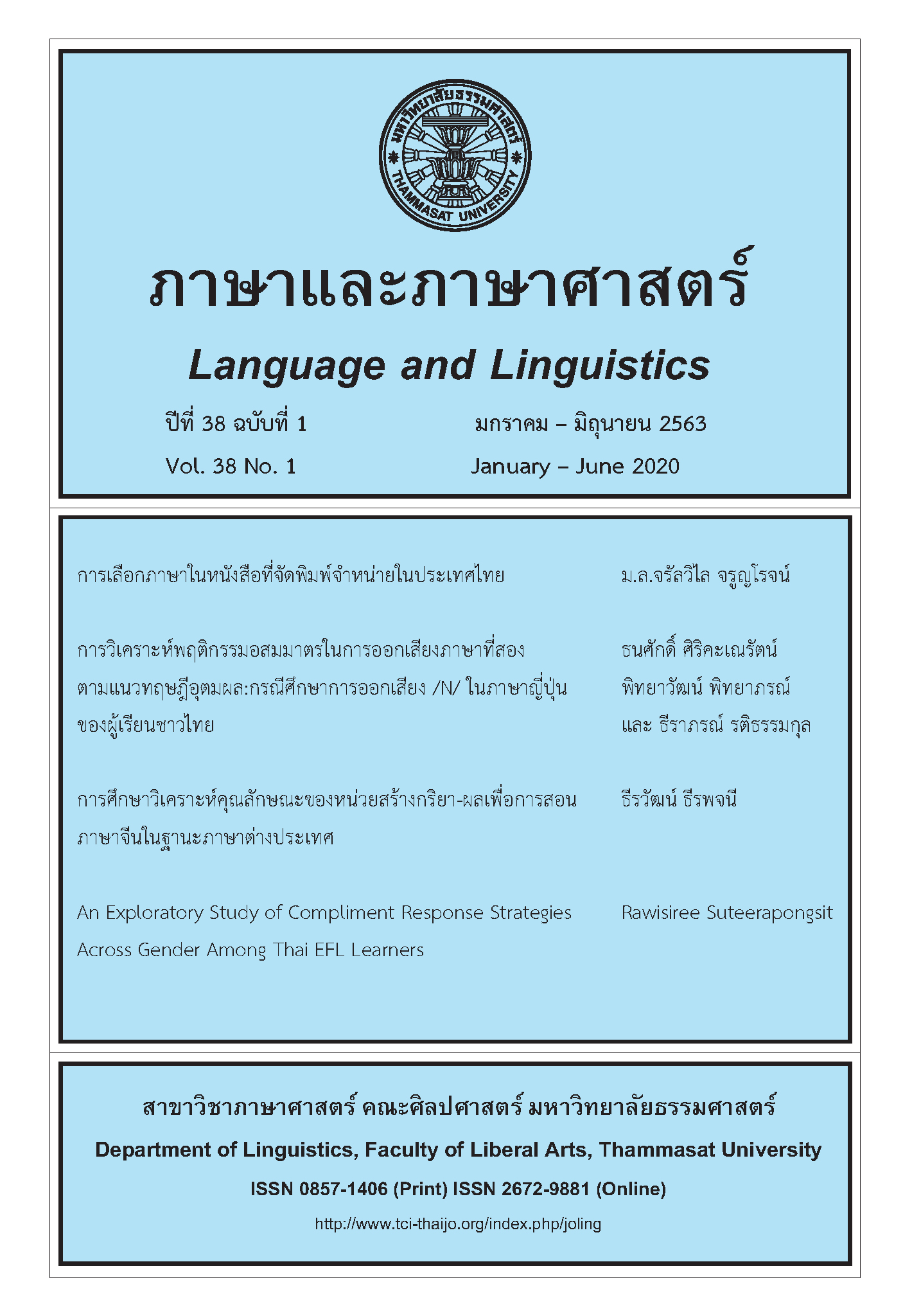การวิเคราะห์พฤติกรรมอสมมาตรในการออกเสียง ภาษาที่สองตามแนวทฤษฎีอุตมผล: กรณีศึกษาการออกเสียง /N/ ในภาษาญี่ปุ่นของผู้เรียนชาวไทย
Main Article Content
Abstract
Markedness in place of articulation can be found in different languages of the world. However, most research tends to focus on markedness in first language alone. de Lacy (2006) proposes an analysis using the Optimality Theory (OT) framework and states that the markedness phenomena arises from the interaction of markedness constraints that reflect the following universal hierarchy of markedness of place of articulation: dorsal > labial > coronal. The present study aims to test if constraints proposed by de Lacy (2006) can account for speech production in a second language. Production of the Japanese phoneme /N/ by Thai learners was used as a case study. Japanese /N/ always assimilates with the following segment in terms of place of articulation. Therefore, the production of /N/ that is not assimilated by Thai learners should reveal their constraints ranking. In the experiment, fifteen participants were instructed to read target words in carrier sentences. All target words were bi-syllabic words, with the first syllable ending with /N/ while the onset of the second syllable was [m], [n], or [ŋ]. The words were not real words in Japanese. Results showed that the participants produced /N/ as assimilated and non-assimilated. The analysis reveals that constraints proposed by de Lacy (2006) can account for data found in this study. Nonetheless, some limitations exist. It must be assumed that if the segment following /N/ has the coronal feature, the input is always [ŋ_cor], and if the segment following /N/ is labial, the input is /n_lab/ or /ŋ_lab/ while the output is [n_lab] or [ŋ_lab], respectively.
Article Details
บทความทุกบทความเป็นลิขสิทธิ์ของภาษาและภาษาศาสตร์
References
ธนศักดิ์ ศิริคะเณรัตน์ (2555). การรับการกลมกลืนฐานกรณ์เสียงพยัญชนะท้ายนาสิกตามเสียงที่ตามมาในภาษาญี่ปุ่นของผู้เรียนคนไทย: การศึกษาตามแนวทฤษฎีอุตมผล. (วิทยานิพนธ์ปริญญามหาบัณฑิต). จุฬาลงกรณ์มหาวิทยาลัย, กรุงเทพฯ.
Battistella, E. L. (1990). Markedness: The evaluative superstructure of language. Albany, NY: State University of New York Press.
Chomsky, N., & Halle, M. (1968). The sound pattern of English. New York, NY: Harper & Row.
de Lacy, P. (2006). Markedness: Reduction and preservation in phonology. Cambridge, England: Cambridge University Press.
Gnanadesikanm, A. E. (1995). Markedness and faithfulness constraints in child phonology. Rutgers Optimality Archive, 67.
Retrieved from http://roa.rutgers.edu/files/67-0000/67-0000-GNANADESIKAN-0-0.PDF
Hayes, B., Tesar, B., & Zuraw, K. (2013). OTSoft: Optimality Theory Software (Version 2.5) [Computer Software]. Retrieved from http://www.linguistics.ucla.edu/people/hayes/otsoft/.
Hume, E. (2003). Language specific markedness: The case of place of articulation. Studies in Phonetics, Phonology & Morphology, 9(2), 295-310.
Hume, E., & Tserdanelis, G. (2002). Labial unmarkedness in Sri Lankan Portuguese Creole. Phonology, 19(3), 441-458.
Labrune, L. (2012). The phonology of Japanese. Oxford, England: Oxford University Press.
Lombardi, L. (1995). Why place and voice are different: Constraint-specific alternation and Optimality Theory. Rutgers Optimality Archive, 105. Retrieved from http://roa.rutgers.edu/files/105-0000/105-0000-LOMBARDI-0-1.PDF
Lombardi, L. (2002). Coronal epenthesis and markedness. Phonology, 19(2), 219-251.
Lombardi, L. (2003). Second language data and constraints on manner: Explaining substitutions for the English interdentals. Second Language Research, 19(3), 225-250.
Prince, A., & Smolensky, P. (1993). Optimality Theory: Contraint in generative grammar: ROA version. Retrieved from http://roa.
rutgers.edu/files/537-0802/537-0802-PRINCE-0-0.PDF
Prince, A., & Smolensky, P. (2004). Optimality Theory: Constraint interaction in generative grammar. Malden, MA: Blackwell.
Smolensky, P. (1993). Harmony, markedness and phonological activity. Rutgers Optimality Archive, 87. Retrieved form https://ling.auf.
net/lingbuzz/repo/ROA/article/000076?id=87&repo=ROA


